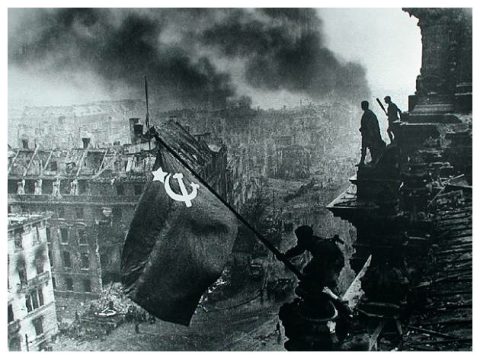
As the Nazi regime began to capitulate in 1945, American, British and Soviet troops pushed into Germany and occupied captured territory. Along with France, they formed the Allied Control Council to replace the Nazi government and administer post-war Germany. The Allied occupation was to be coordinated from one location, Berlin, which itself would be segmented into occupied zones. The Soviet Red Army was the first to arrive in Berlin in April 1945, prompting Adolf Hitler‘s suicide and the surrender of the German high command. For two months Russian generals refused to allow Allied troops into the capital. Meanwhile, the Soviet occupation forced engaged in an orgy of murder, looting and sexual violence (as many as 400,000 Berlin girls and women were raped by Red Army soldiers). American and British military personnel entered the German capital in July. Under the terms of a previous agreement, the London Protocol, they began setting up discrete occupation zones in the city’s west (Britain) and south-west (American). Weeks later they were joined by the French, who occupied a small sector in the north-west. The Soviets controlled almost all of Berlin’s eastern half.
The Allied occupation forces were shocked by the devastation in Berlin. The city had almost no means of sustaining itself. Greater Berlin produced only two percent of its food requirements; the rest had to be shipped in from rural areas. Food supplies were exhausted and thousands of Berliners were starving. Months of heavy bombing had destroyed buildings, factories, homes and critical infrastructure. All of Berlin’s 87 sewage networks had been destroyed, spoiling drinking water supplies and spreading diseases like typhus and dysentery. Hospitals, railways and roads had been decimated by aerial bombing and artillery fire. Many Berliners had long since fled the city, fearing the advancing Soviet troops. This exodus saw Berlin’s population drop from 4.6 million in 1944 to 2.8 million in mid-1945.

The Allied occupation zones in Berlin were enclaves in the heart of Soviet-occupied eastern Germany. The Americans, British or French could not move men and supplies in or out of Berlin without crossing Soviet-held territory or airspace. This was not a concern while there was considerable goodwill in Soviet-Allied relations. In 1945 Red Army commander Marshal Zhukov granted the Allies permission to use one road, one rail and one aerial route across the Soviet zone. In later negotiations, the Allies were granted three twenty-mile corridors into Berlin – but these agreements were intended to be temporary. As relations deteriorated, the Allied presence in Berlin became irksome for Soviet leader Joseph Stalin, who had wrongly believed the Americans would withdraw from Berlin after a year or two.
“The Western counter-blockade of eastern Germany… hurt the eastern occupation zone and Soviet standing in Germany more than the Soviet blockade hurt the western zones. Eastern Germany lacked sufficient quantities of essential industrial material like coal and steel, and there was no equivalent to the airlift that could supply these necessary commodities. Francois Seydoux de Clausonne, a French government advisor on Germany, conjectured that the Berlin Blockade was worse than a failure – it was a political embarrassment to the Soviet Union.”
Roger R. Miller, historian
In 1948 Stalin met with Wilhelm Pieck, his German henchman in the Soviet zone and the future president of East Germany. Pieck complained that the presence of the Americans, British and French in Berlin threatened to disrupt elections scheduled for 1949. “Let’s make a joint effort then,” Stalin told him, “and perhaps we can kick them out”. On Stalin’s orders, the Soviet regime in Germany launched a campaign to frustrate the Allies out of Berlin. Soviet troops began stopping Allied trains to check passengers and cargo, while Russian planes began entering Allied airspace over Berlin to menace planes flying in or out of the city. Relations worsened significantly in April 1948, after a Soviet fighter ‘buzzed’ a British commercial passenger plane and caused it to crash, killing all 14 people onboard. On June 20th the Allies issued a new currency called the Deutschmark; the Soviets ordered that this new currency would not be accepted in its zone. Four days later, on June 24th, Soviet forces implemented a full-scale blockade of Allied zones in West Berlin. The Russians closed the land corridors, halting Allied road and rail shipments and sending them back to their points of origin. They shut down thoroughfares and services into West Berlin, closed roads, cut telephone lines and blocked water supplies. Power lines into West Berlin from electrical stations in the Soviet zone were also disconnected. By late June, the Allied sectors of Berlin were almost completely blockaded; only the air routes remained open.

Many Americans now believed that remaining in Berlin was untenable. There was no military option available: the United States had just 9,000 troops stationed in Berlin and another 110,000 in Bizonia, compared to more than one million Russians in the Soviet zone. At the end of June, Berlin’s allied zones had only five weeks’ of food stores and six weeks’ of coal remaining. The Soviets had just signed an agreement guaranteeing three flight paths into Berlin from Bizonia, so an airlift of food, coal, gasoline and machinery appeared the only means of re-supply. An airlift to keep West Berlin fed and fuelled, however, would be a monumental task. Planes would need to move 5,000 tons of supplies per day – and the largest American cargo plane carried barely four tons. An airlift would require thousands of flights each week, an adventure costing millions of dollars. There was also the possibility that the Soviets might breach their 1945 agreement and attack cargo planes.
Despite these difficulties, the Berlin airlift was authorised…. and began in the final week of June. Some significant facts about the airlift include:
Some significant facts about the airlift:
- The Berlin airlift was code-named Operation Vittles and was overseen by US Air Force General Curtis LeMay. The operation would use almost 700 planes and 12,000 personnel from the US, Britain, France, Canada, Australia, New Zealand and South Africa.
- A study carried out by the Allies determined that based on minimum rations, West Berlin’s two million people required 646 tons of flour and wheat, 125 tons of cereal, 64 tons of fat, 109 tons of meat and fish, 180 tons of potatoes, 180 tons of sugar, 11 tons of coffee, 19 tons of powdered milk, five tons of real milk for children, 144 tons of vegetables, 38 tons of salt and 10 tons of cheese – a total of around 1,540 tons per day.
- In addition to food, the airlift shifted more than 1.5 million tons of coal and four million litres of gasoline. Among the more unusual items carried in the airlift were gigantic rolls of newsprint for West Berlin’s newspapers and two million seedlings to replace trees destroyed during the war.
- The airlift involved more than 277,000 separate flights, the first of these on June 26th. In total, Allied planes flew more than 92 million miles – the distance of more than 190 round trips to the Moon. Allied commanders routinely shortened launch timings, safety and inspection procedures in order to fly more cargo runs. One general aimed to achieve 1,440 Berlin landings per day – one for each minute of the day – a target finally achieved in August 1948.
- The airlift was a challenge for pilots and aircrew alike. Not only were crews required to battle fatigue by flying several sorties each day, conditions were often extremely difficult. Berlin’s airports were prone to fog and low cloud, while the approach to Tempelhof airport in the US zone required pilots to fly between high-rise apartment buildings. Planes were often loaded up to or just over their cargo limit; this made them difficult to take off and manoeuvre. Twenty-five Allied planes crashed during the airlift, killing 70 pilots and crew.
- The airlift began slowly, averaging just 90 tons of supplies a day in its first week. After the arrival of new planes, these figures rose to 1000 tons per day in the second week. The record single-day tonnage was set in a 24-hour period during Easter 1949 when Allied planes transported just under 13,000 tons of supplies.
- West Berliners offered to assist with the unloading of landed planes, in return for extra food rations. As the airlift progressed, these volunteer crews became very fast (at one point, twelve men unloaded a ten-ton cargo of coal in under six minutes). This allowed for fast turnarounds: some Allied planes spent barely 15 minutes on the tarmac in Berlin before returning to Bizonia for another cargo run.

The pro-Soviet press in East Berlin mocked the Allied airlift as a futile exercise, claiming it would fail within days or weeks. Instead, the Berlin airlift, like the Marshall Plan, became an important propaganda victory for the United States and its allies. One poster, produced by a participating aircraft company, hailed milk as the “new weapon of democracy”, declaring that 2.5 million Germans were enjoying a better life due to air transport. The success of the airlift proved embarrassing for the Soviet Union. In April 1949, Moscow proposed negotiations to end the blockade of Berlin. The Soviets agreed to reopen land access to the city and, at 12.01am on May 13th, the first Allied train for 11 months rolled into Soviet-occupied East Germany, reaching Berlin shortly before dawn. The airlifts continued for another nine weeks, in order to build up a surplus of supplies, before they finally ceased in late July.

1. After 1945 the German capital Berlin was divided into zones, occupied by the US, Britain, France and the USSR.
2. In 1948 Stalin and the East German government resolved to force the Allies out of Berlin by denying access.
3. As Stalin tried to starve them out of Berlin, the West held firm and decided to supply its sectors by air.
4. The Berlin airlift was the largest air supply campaign ever attempted, with more than 550,000 different flights.
5. The airlift proved embarrassing for the USSR, which in April 1949 agreed to negotiations for the re-opening of Berlin. Rail access was eventually granted in May 1949 and supply flights continued until late July 1949.
Content on this page is © Alpha History 2018. This content may not be republished or distributed without permission. For more information please refer to our Terms of Use.
This page was written by Jennifer Llewellyn, Jim Southey and Steve Thompson. To reference this page, use the following citation:
J. Llewellyn et al, “The Berlin blockade”, Alpha History, accessed [today’s date], https://alphahistory.com/coldwar/berlin-blockade/.
